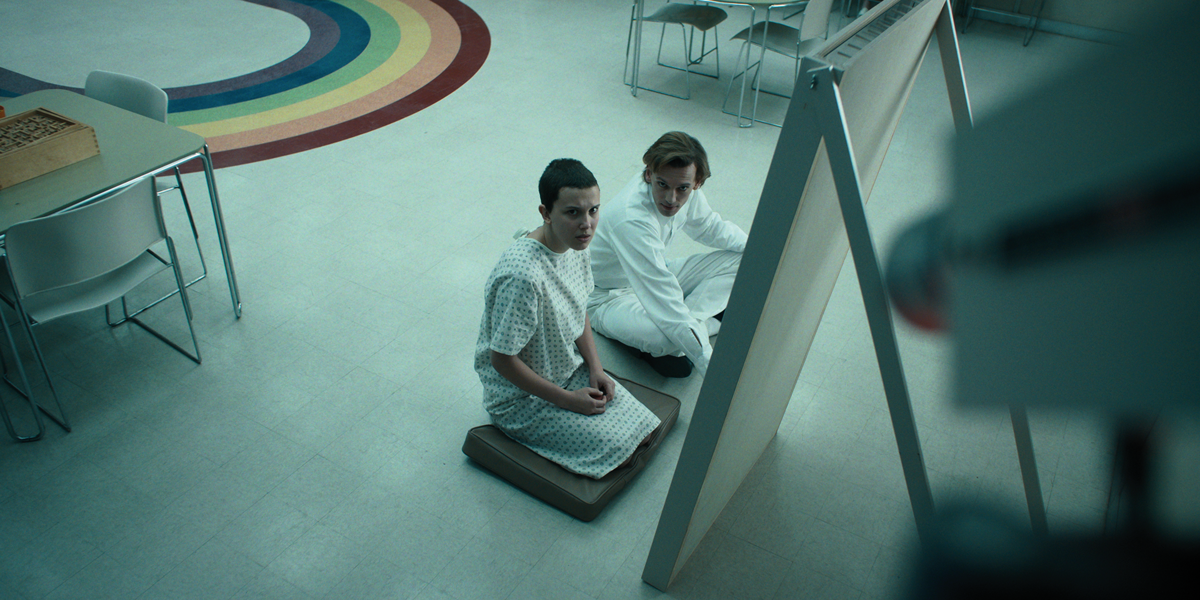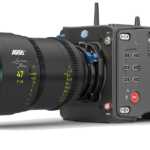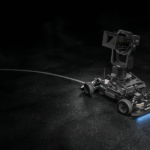
Going up to Eleven
Posted on Jul 19, 2022 by Samara Husbands
Stranger Things is back for a fourth season and, as DOP Caleb Heymann tells us, it’s arguably his most challenging project yet
Words. Roger Payne | Images. Netflix
Spare a thought for Caleb Heymann. In late 2019, the sci-fi-loving cinematographer landed a dream job – working with the Duffer Brothers as one of two DOPs on Season 4 of Stranger Things. He’d already read the scripts of the supernatural horror-drama and spent the next four months prepping to take the reins for four episodes. But just as shooting was due to start, the industry was turned upside down. The US – along with most of the world – went into Covid-19 lockdown, and production was delayed until August 2020.
“We felt like guinea pigs, as we were one of the first shows to start up again,” recalls Heymann. “Only certain people could go into red zones with the actors, we had to work out who was staying in the green and yellow zones, whether you had to wrap equipment in plastic or even have a drink. It was a journey into the unknown.
“A couple of times an actor tested positive, and we had to come up with something else to shoot – there was no way we couldn’t work for a week once we’d restarted,” he continues. “There was always some other piece to do, but often it wasn’t planned. So, rather than being in this distinctive block system where you’d be working on two episodes at a time, in the first few weeks we were doing scenes from episodes 7, 8 and 9 that hadn’t been fully prepped.
“It was a real nightmare for continuity, because you were locking in hair and make-up, the look of bruises and the way dirt was falling on somebody, for something you’re going to be shooting in nine months’ time. We were often tackling seven episodes in a week, or four episodes in a single day, just to always be shooting something.”
Talking last month, Heymann appears to have emerged unscathed from what he describes as ”a full year of crazy, long weeks and hard work”, putting much of his sanity down to his meticulous paperwork admin, paired with galleries of stills shot on-set. “The Duffer Brothers knew what they wanted, so it was always just a conversation away. But I needed spreadsheets!” he smiles. “They were colour-coded for different storylines, each had a one-line description of what happens in a scene and any special equipment we needed. Between that and the stills that detailed all the set-ups, it was the only way to keep sane!”

In truth, Heymann wasn’t a complete – erm – stranger to the show. He’d worked as second unit DOP on Season 3, giving him a first taste of a giant production, but was more used to working on independent films, only shooting his first feature in 2015. The big break came in 2018 when director Leigh Janiak – herself a young director – brought him in as DOP for the Fear Street trilogy, eschewing the typical route of employing a seasoned veteran for the camera work. “With a young director, the natural thing to do is get an experienced DOP,” confirms Heymann, “but Leigh and I had known each other for a while, and she responded to the lookbook I put together.”
As a new project, Heymann had been able to define and influence the look of the Fear Street films from the outset, but what of Stranger Things? An undeniable jewel in the Netflix crown, and with three seasons already out in the wild, all with their own predefined aesthetic, surely he would have some degree of creative restriction? “We didn’t inherit lighting diagrams or rule books from seasons past – there was inherent trust that you are going to continue in the spirit of the show and what’s already been established visually,” explains Heymann. “From reading the scripts, I knew we were using new locations that we could define the look for. One of the first things we did was develop lookbooks to tease out how the overall mood, tonality and colour palette for these locations would appear. But the sets that had been used before – like the basement where the characters play Dungeons & Dragons – you want to respect that and not have too much of a departure.
“Without a doubt this is the darkest, most adult season to date,” he continues. “In Season 4, the story expands beyond Hawkins. You have the California storyline with Joyce, Jonathan, Eleven and Will, which we wanted to have its own look and feel – warmer, pastels, sunnier – but also a harshness that felt threatening. Then you have the Russian storyline where Hopper is, which is darker, low-lit, moody and very cool. It leans into the blues, but also with old-school practicals, like uncorrected fluorescents and sodium-vapour lights.
“Hawkins was very colourful in Season 3, particularly the Starcourt Mall, but in the wake of where everything left off, it’s now a much more sombre tone. Even if we were shooting scenes in the school, we made it as dark as possible, turning off many of the overheads to bring in shadows and silhouettes. Similarly, Max is living in a trailer park with her alcoholic mother. We tried to make that gritty, so it looked like 8 Mile, with uncorrected fluorescents and dirty colour temperatures. We also shot handheld in the trailer park – an approach which hadn’t been used in the show, providing a unique sense of immediacy.”
Further new ground was trodden in the choice of cameras and lenses. Previous seasons had been shot on different flavours of Red – the Dragon for Season 1, Helium for Season 2 and Monstro for Season 3 – along with Leica optics; Summicrons initially, then Thalias when the cameras switched from Super 35 to full-frame. This reliance on Reds was largely down to Netflix’s 4K requirements, but also because they were integral to the show’s look. “We tested out the Reds alongside the Arri Alexa LF and Mini LF, plus six or seven different lenses,” says Heymann. “We quickly found that we could achieve the same look with Arri that both Lachlan [Milne, second DOP on Season 4] and I were more accustomed to. It gave us a slight edge in the highlights.

“After a season of Thalias on the Monstro, everyone was accustomed to the field of view that comes from full-frame, so we stuck with that, but it means limitations in terms of optics. We settled on Camtec Falcons – primarily rehoused Canon FD lenses. The older coatings give a certain texture, there’s more highlight halation, warmth and flare. It gave us enhanced texture, whereas the Thalias were cleaner, more pristine.
“With the Mini LF, we could meet the 4K requirements, but in smaller form, so we’d mix and match according to requirements. It still had the look we wanted once the colourists were able to do an Alexa version of the show LUT. We kept one LUT throughout and there’s no DIT, so a lot of the look comes from lighting.
“We used very little white light and the camera was rarely set to a tungsten or daylight colour temperature – it was often somewhere between 3800 and 4200K. Then you have a practical that’s really warmed up, often sitting at 2800 or 2600K especially for night work, so you have this colour contrast,” Heymann asserts. “Depending on the mood of the scene and where you want daylight to be reading, we’d go with a cold sun when the characters’ emotional states called for something stark or foreboding.”

With the aesthetics nailed down, execution became primary – along with an appreciation of the scale of the task at hand. Despite this, Heymann remained undaunted, employing principles he’d learned on $1-2 million indie films. “Ultimately, regardless of the budget, the same rules apply. It’s just a question of how big the spaces are and how many tools you have to control it, becoming more about communication,” he explains. “It takes a while to figure out how this giant machine operates. This is especially pertinent with second units. You’re trying to tie together scenes that had a certain look the last time you saw them because one director was working, then the next episode has a completely different visual with a new director! Bridging that gap is about
being prepared, but also who you converse with, which members of the crew you tap into.”
As if to prove this point, Heymann explains one of the more complex scenes, which takes place on water. “Eddie – a new character – has a lakeside boathouse. There’s a sequence at night that involves stunts levitating above the water and also extensive set pieces underwater,” he tells us.
“We were shooting in multiple seasons – the story takes place during spring break – so we needed the trees to be slightly green and the water to not be so frigid that people couldn’t get in it. We had to shoot some in winter, some in spring, and bridge those together. Then some on a stage in a purpose-made 50ft water tank.

“There’s an underwater rift with interactive lighting, which one of the characters gets pulled through at the bottom of the tank. But then it had to be flipped upside down with the top of the tank appearing as the bottom of the lake, so the lighting had to be reversed. There are a number of shots like this where you’re moving from one world the right side up, into the Upside Down where you have to match the speed of movement and the framing – and then pop out on a different set. The logistics of figuring that out, especially with the underwater set and the fact it’s all getting shot six months apart, was pretty insane!”
Insane perhaps, but Heymann’s relative lack of big-time experience did not hamper his creative input. Initially booked as DOP for four episodes, he ended up completing a total of seven, and is now in line for potential Emmy success. Legions of fans will be relishing the return of Stranger Things for a fifth season. And should Heymann be called, he’ll be ready to turn his world Upside Down once more.
First featured in the July 2022 issue of Definition.
For more on Caleb Heymann, see his website.
Watch Stranger Things Season 4 on Netflix.











